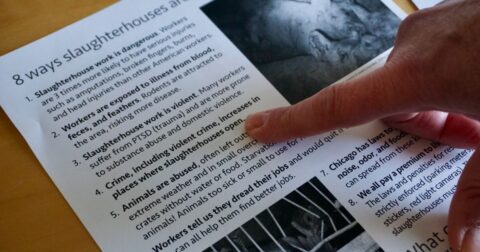Solutions
West Hollywood Committed to Plant-Based Food. Here’s What That Looks Like So Far
Climate•6 min read
Solutions
What local activists can take from their example.


Words by Grace Hussain
Lisa Castagnozzi considers herself an engaged community resident. The longtime animal rights activist stays plugged in on local issues, yet even she was surprised to learn a new slaughterhouse was planned in Milwaukee, right up until approval for the development of the land was poised to pass the city council. Castagnozzi wasn’t alone. Most of the community had been left in the dark, it turned out. Once Castagnozzi and the group Slaughter Free Milwaukee found out, they jumped into action to spread word of the planned slaughterhouse — ultimately winning their fight to prevent the plant from being constructed.
Though the slaughterhouse was planned for Milwaukee’s Century City Business Park — a district that city officials have struggled to get businesses to move into — numerous residential neighborhoods would be affected. Yet initially, only a few people were there to weigh in on the proposal at the public council committee meeting where the proposal was first addressed.
It was at that meeting that members of the council, including Alderman Robert Bauman, began questioning company representatives, and learned what the company was proposing was a slaughterhouse. The facility would slaughter roughly 500 cattle daily, including animals from Illinois, Montana, Wisconsin and the Dakotas, according to the company’s representative at the meeting.
At a zoning meeting held a week later, Alderman Robert Bauman called these suspiciously quiet efforts a “strange proceeding,” pointing to the lack of briefing by the Department of City Development and the absence of citizens weighing in during the public comment period.
“There was nobody there,” he said during another zoning meeting. “There were no citizens in support and no citizens in opposition.” The effort to keep the new facility proposal quiet was alarming to Castagnozzi, both as an animal rights advocate and a member of the community.
“We didn’t know anything about a slaughterhouse potentially coming into Milwaukee,” she says, calling it “kind of out of the blue.” The fact that the meat processing plant would be constructed in a “city-owned lot” meant the community should have a chance to weigh in, she says.
Alderman Bauman expressed similar concern in his public comments. “Slaughterhouses and…all types of businesses that produce noise and dirt and odor have historically had a stigma in central city communities,” he pointed out in his remarks to the full city council. “Why? Because for whatever reason, those types of negative land uses just seem to always end up in poor neighborhoods — primarily neighborhoods of color.”

Once Castagnozzi and her small cohort of animal rights activists did learn about the proposed measure, they had just a few days before the next meeting was scheduled to get the word out. With limited time and resources, the group took to online and physical spaces to reach community members, and began to make headway. “We as a group, made flyers, did social media, we physically spread out in the community and went to the coffee shops,” she says.
Some policymakers “don’t care what kind of jobs they are, how much they pay or what the working conditions are like — they’re jobs,” says Robert Grillo, head of Slaughter Free Network. According to government documents, the facility would have paid employees an average of $17 an hour — significantly above the city’s $7.25 minimum wage but well below the salary needed to live comfortably in Milwaukee.
Milwaukee’s residents do care, it turns out. In a matter of days, activists organized dozens of opposition letters and delivered them to council members. “Jobs are not just jobs. Slaughterhouse work is among the most exploitative, dangerous and relatively low paid work in the market,” reads the letter signed and sent by many of the opposing residents.
During a city council meeting, Alderman Khalif Rainey who at the time represented the neighborhood raised objections to campaign efforts. Rainey argued that the letters were not reflective of the community, and that he had received messages from people out of the state, but barely heard from his own constituents.
Though he voted to send the proposal back to committee for further discussion, Rainey argued that the jobs it would bring would improve the lives of the majority-Black community in which the slaughterhouse would be constructed. “That’s a good, well-paying job,” he said in the council meeting, “so again, it’s crazy how all roads lead back to this one question: do Black lives matter?”
Castagnozzi disagrees. “No one we spoke to was for it,” she says. At one community cafe near the proposed site, Castagnozzi says, none of the customers knew what was planned and, when they found out, they were appalled. “They just couldn’t believe it. Like, ‘what do you mean? Like, that’s the business they’re going to put in our neighborhood’.”
Getting communities to agree, collectively, to oppose a local initiative that offers jobs can be difficult. “People are afraid of retaliation. People are afraid of speaking out or they have certain relationships, and they’re worried about those relationships causing them problems with their work or in their personal life,” says Grillo.
It’s a risk that paid off for the Wisconsin group that have now organized themselves as an official chapter of the larger national organization. Strauss canceled their plans to build a new facility in Milwaukee. Ted Beneski, head of Insight Equity Holdings, LLC, which owns a majority share in Strauss Meats, sent an email from his iPhone to Grillo. The company’s “strategy has changed,” it read, and Strauss is “not planning to build a slaughterhouse [in or near Milwaukee] or anywhere else for that matter.” Earlier that summer, the remaining Strauss Meats slaughterhouse in the Milwaukee area was also shuttered. According to a press release the decision was the result of their recent divestment from the lamb and veal businesses, combined with the relocation of their beef operations to Illinois.
To persuade community residents to speak out, advocates and organizers have to “create a tension,” says Grillo. “It’s a moral crisis,” he adds. “You have to create that to get people to take sides.”
This story is part of a series called How Food Justice is Made: Stories and Solutions, in which Sentient dives into four different communities, and the unique ways they’re combatting slaughterhouses.